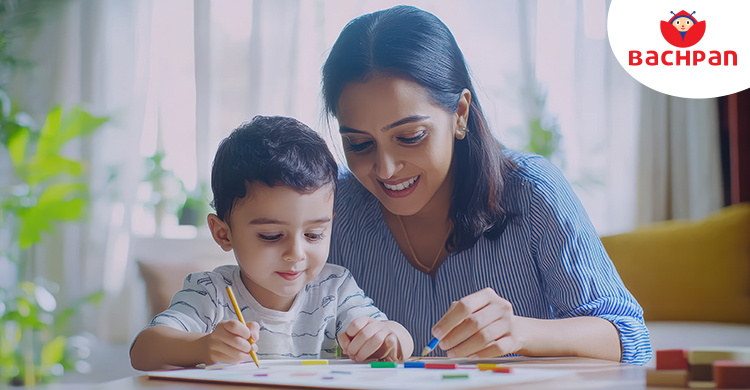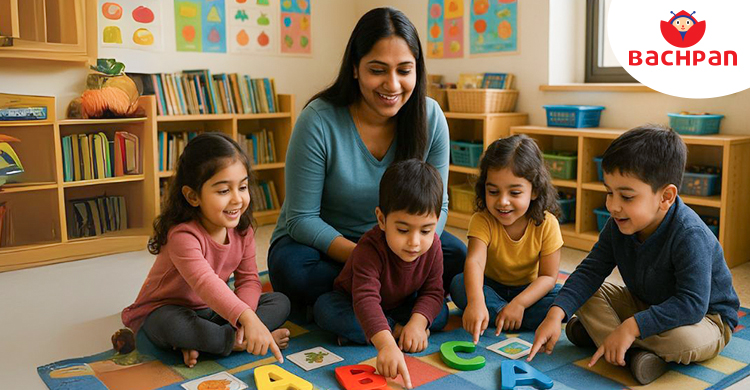Fun And Easy Ways To Teach Phonics To Preschoolers

Phonics is a method of teaching letters and associating them with their respective sounds. It is essential to teach phonics to preschoolers, as this method helps children become familiar with the alphabet and lays a strong foundation for learning and creating new words.Yes, teaching phonics is important, but how teachers teach it also matters. Today, we will take you through the easy and fun ways to teach phonics to preschoolers.
What Is Phonics and Why Is It Important to Preschoolers?
The association of letters to their sounds is what’s known as phonics. Preschoolers need to learn phonics. But why is it important? The following section discusses this.
Understanding the Basics of Phonics
Preschoolers who understand the foundations of phonics develop their vocabulary and learn how to construct words and sentences on their own. They are also able to comprehend the meanings of various words, which leads to their improved reading comprehension. As a result, children become fluent readers.
How Phonics Supports Reading and Language Skills
Kindergarteners eventually begin to comprehend the connection between words and sounds as they begin learning the phonics approach. The repeated practice of this strategy makes toddlers familiarise with the phrase, and enables them to decode different words. The pronunciation and speaking skills are enhanced as a result.
Benefits of Early Phonics Instruction for Preschoolers
There are several advantages to teaching preschoolers phonics. As their vocabulary and fluency improve, it gives them more self-assurance. Building a solid literacy foundation enhances their ability to decode, which in turn enhances their written and spoken communication abilities.
Best Ways to Teach Phonics to Preschoolers
Preschoolers can learn faster if the appropriate way of teaching is followed. Let’s see some of the best ways to teach phonics to Preschoolers.
Start with Letter Sounds Before Letter Names
Teachers should first teach preschoolers letter sounds, as it enables the kids to read and decode words on their own. It helps the kids write at a young age since they can break words down into sounds instead of memorizing spellings by heart.
Use Visuals, Songs, and Story-Based Learning
Attractive visuals and stories, along with songs, make the learning experience fun for the preschoolers. It improves memory retention and captures children’s interest. They will learn phonics in fun ways and never feel bored. As a result, they will understand the basics of the phonics concept in addition to memorizing it more quickly.
Benefits of Early Phonics Instruction for Preschoolers
Learning phonics helps kids become more confident readers by helping them associate letters with sounds. Their vocabulary expands as they encounter new terms. Because they can read the words fluently, their comprehension abilities also improve.
Keep Lessons Short, Repetitive, and Interactive
Kids have a small attention span, so keeping the sessions short and interactive avoids boredom among children, and they learn and memorise better. Through repeated use of the phonics method, children get used to the letters and their sounds. Additionally, creating interactive sessions also helps them pay attention, which keeps them interested and motivated to participate.
Fun Activities to Teach Phonics to Preschoolers
The kids love having fun, so why not make teaching enjoyable as well? The following fun activities to teach phonics to preschoolers are as follows:
Sound Matching Games and Letter Hunts
Children learn about the various sounds in words through sound-matching games. They get the ability to recognize, match, and arrange sounds through these games. Letter Hunts inspire children to search their daily surroundings for letters that produce particular sounds. This method of active learning allows children to make the connection between letter shapes and sounds with the aid of this active learning strategy.
Phonics with Flashcards, Blocks, and Puppets
This is one of the most fun and creative activities to teach phonics to preschoolers. Make flashcards of the letters and ask the kids to choose a letter from these cards. For example, if they choose the letter “C”, ask them to identify its corresponding sounds and objects. Use a puppet to create a short, funny story using as many words as possible that begin with one letter.
DIY Crafts and Songs to Reinforce Letter Sounds
Through crafting, kids can develop a lasting relationship between letters and sounds by utilizing their imagination and motor skills. Many of these fine-motor alphabet crafts — such as alphabet animals, letter collages, sound jars and tactile letter tracing — get kids learning about letter sounds in a tactile, visual way. Children learn best through hands-on, creative experiences. Each letter becomes remembered and piques curiosity thanks to these imaginative exercises.
How to Create a Phonics-Friendly Learning Environment
Making a phonics-friendly learning environment for children helps them stay engaged in learning and memorising the letters. Let’s find out how to teach phonics to preschoolers through a friendly learning environment.
Set Up a Print-Rich Corner at Home or in Class
Establishing a print-rich area in the classroom or at home is a great method to develop early literacy abilities in an interesting and natural way. Kids should be surrounded by printed words. Keep books close at hand, label home objects, and hang alphabet posters. Reading is promoted and phonics instruction is reinforced in a setting with lots of print.
Use Everyday Moments for Sound Practice
Parents and teachers can develop children’s phonics abilities organically and joyfully by turning ordinary situations into sound practice opportunities. Everyday situations offer several opportunities to learn letter sounds, whether taking kids to the grocery store, bathing them, or taking them for a stroll.
Encourage Repetition Through Play and Conversation
Incorporate sounds into everyday activities through playful interactions, as the children thrive on hearing and repeating sounds. Children can repeat important sounds through narrative, pretend play, or by using their favourite objects. Engage in simple back-and-forth activities such as “I see something that begins with ‘S’ “, or perform tongue twisters and rhymes that highlight specific letters.
Common Mistakes to Avoid While Teaching Phonics
Preschoolers will find the phonics lesson more enjoyable if mistakes are avoided. When teaching phonics, steer clear of these common blunders.
Don’t Overwhelm with Too Many Sounds at Once
Kids need time to become familiar with the letters and their sounds. Overwhelming them with too many sounds at once makes them lose their interest, and they can become confused and frustrated as well. Concentrate on just one or two letter sounds at a time, making sure to practice them frequently through games, songs, crafts, and everyday conversations.
Avoid Skipping Blending and Segmenting Steps
Blending and segmenting steps help children learn and become familiar with the letters. Avoiding these steps may create a lack of understanding and reduce reading fluency due to learning gaps. Practicing blending and segmenting regularly through playful activities develops confidence and reading fluency among children.
Don’t Rely on Memorization Without Understanding
Children may pick up a few common words quickly, but they will find it difficult to decode new words if they memorize them without understanding. Instead, focus on teaching them to explore word construction, practice segmenting and blending, and understand the connections between letters and sounds. This method increases comprehension and strengthens their capacity to read new words on their own.
Conclusion – Make Phonics Fun, Not Forced
Teach phonics to preschoolers in an engaging and enjoyable manner. If it is taught in a forced way, children might lose interest and motivation to learn the letters. Learning phonics should be an enjoyable experience rather than a demanding task. The true objective is to foster a lifelong love of reading in children by gently guiding and encouraging them to explore sounds in ways that suit their interests and pace. At Bachpan, the Bachpanites are taught phonics through playful short stories, funny sounds, and vibrant objects. This strengthens their foundation and helps in memorisation.






